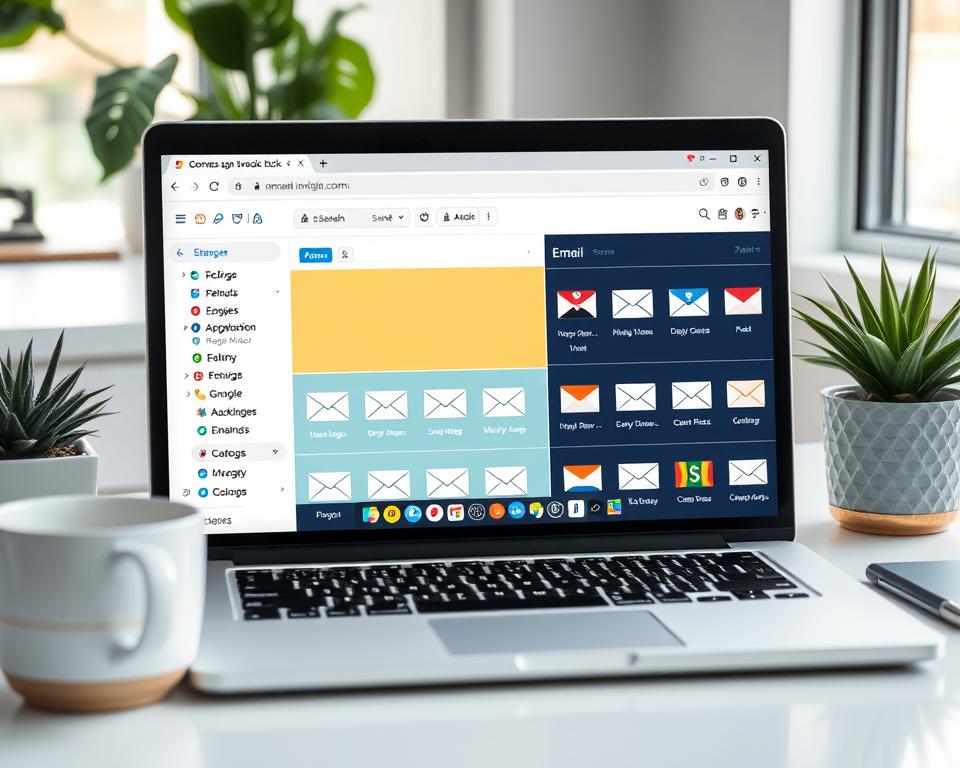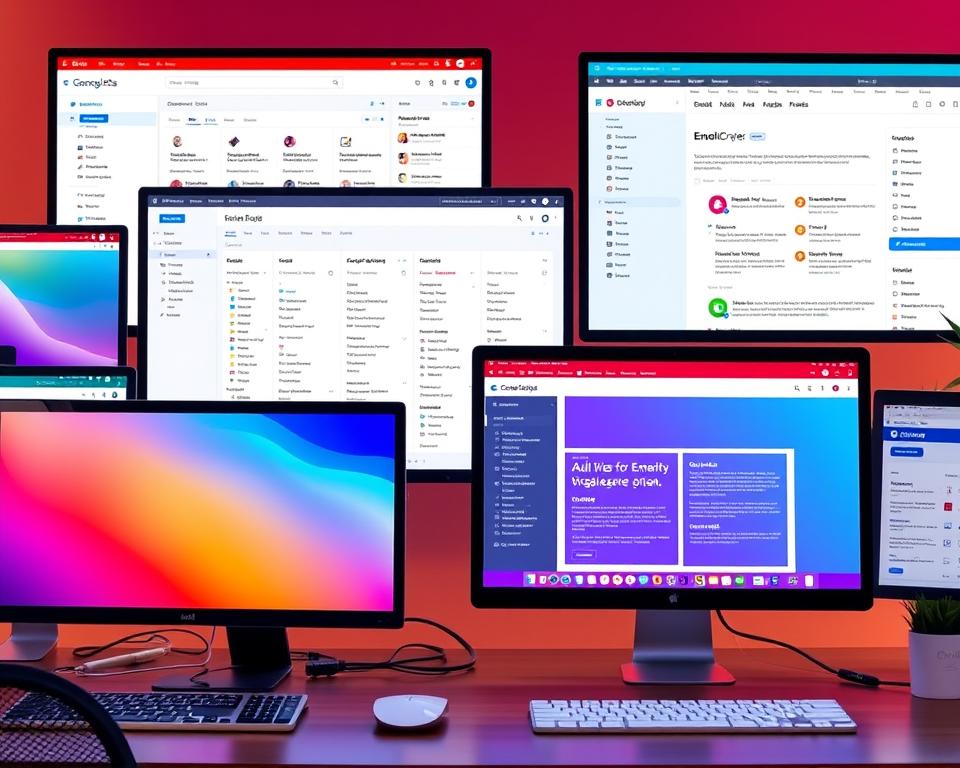I’ve been there – drowning in a sea of unread messages. Important emails get lost in the clutter, and our productivity plummets. But, there’s good news: email management software can save us. These tools can handle thousands of emails efficiently, bringing order to the chaos1.
These software solutions can also boost team engagement and streamline workflows. In fact, teams that are highly engaged show 21% greater profitability. This shows how effective communication tools can make a big difference1. Whether you need to organize your personal inbox or manage team communications, there’s a solution for you.
The market offers a variety of options, from free plans to paid solutions starting at $50 per month2. Popular choices like Help Scout, Sanebox, and Mailchimp meet different needs. They help manage incoming emails, automate sorting, or handle bulk campaigns2.
As we explore email management software, we’ll see how it can change your inbox. We’ll look at advanced search options and automated replies. These features can make your email life easier. Let’s start this journey to take back control of our inboxes and increase our productivity.
Understanding Email Management Software
Email management software is a big help for organizing digital messages. It’s made my inbox much neater and helped me work faster. Let’s explore what this software does and why it’s so important today.
What is Email Management Software?
Email management software helps you deal with lots of emails. It does more than just sort emails. It also organizes, automates, and analyzes your emails. These tools work with popular email services to make your life easier.
Benefits of Using Email Management Software
Using email management software has really helped me. It cuts down the time I spend on emails a lot. Some tools even block 99% of spam and 100% of malware, keeping my inbox safe3.
Being able to find emails quickly is a huge plus for me3.
Key Features to Look For
When picking email management software, I look for these important features:
- Predictive filing using AI for better organization4
- One-click filing to save time4
- Advanced search tools with lots of filters4
- Works well with popular email services4
- Email continuity services for no breaks in service3
It’s interesting to see that top email management tools like Zoho Desk and Google Workspace get great reviews. They have ratings of 4.5 and 4.7 from thousands of users5. These high ratings show how much people value these tools.
My Email Clutter Struggle
I never knew how much email could affect my life until I was overwhelmed. As a professional, I get over 120 emails a day. I used to check my inbox more than 15 times a day6. This constant checking was hurting my productivity.
Recognizing the Need for Change
Things changed when I saw I was spending 28 percent of my workweek on emails7. I felt overwhelmed and knew I needed a change to control my time and focus.
Productivity Drain
Email overload was really affecting my work. Each interruption took up to 23 minutes to refocus6. The constant checking was like a dopamine loop, similar to social media6. I knew I had to change how I organized my inbox.
Finding the Right Tools
I started looking for email management software to help. I found tools like Spike, Gmail, and Outlook could make email tasks easier6. I also learned about the Four D’s framework – Do, Delegate, Defer, Delete – to reduce decision fatigue6.
Using these strategies and trying different software was the start of my journey. It was time to take control of my email habits and find a system that worked for me.
Choosing the Right Software for My Needs
Finding the perfect email management software was crucial for my productivity. I realized I needed a solution that could handle the overwhelming influx of emails. The average employee receives about 100-120 emails daily8.
Factors to Consider Before Buying
I looked for automation, collaboration, and integrations. Security and scalability were also key. I wanted a tool that could grow with my needs and keep my communications safe.
Free vs. Paid Options
I found a range of options, from free to premium. Missive offers a free plan for up to 3 accounts, while paid plans start at $14/user/month89. Microsoft Outlook provides a free version for personal use and starts at $6/user/month for businesses9. These options let me test features before committing.
Popular Email Management Software Reviews
I read user reviews to see how effective they were. SaneBox impressed me with a 4.9 out of 5 rating on G2, offering plans starting at $3.49/user/month8. Front, with a 4.7 rating, starts at $38/month on a yearly contract89. Superhuman, another highly-rated option at 4.7, is priced at $30/month89. These tools promised to transform my inbox from chaos to a well-organized communication hub.
Integrating Software with My Current Tools
Seamless integration is crucial when picking email management software. I aimed to find tools that blend well with what I already use. This search led me to look at different options and how well they work together.
Compatibility with Email Clients
Many email sorting tools work well with popular clients like Outlook and Gmail. I was happy to see that some, like Mixmax and Yesware, start at $34/user/month and $19/user/month. This lets me pick based on my budget and needs10.
Linking to Task Management Apps
About 70% of big companies are using SaaS for productivity. This shows how important it is to link email management with task apps11. Tools like EngageBay, starting at $12/user/month, are great for this10.
Syncing Across Devices
Syncing was key for me. I found that 60% of small businesses like cloud apps that grow with them. This ensures easy syncing across devices11. Mailbutler, starting at $4.95/month, gave me the flexibility I needed without costing too much10.
My research showed the value of choosing tools that are scalable, flexible, and well-documented. This has greatly boosted my email management and productivity.
Features I Can’t Live Without
Email management software has changed how I organize my inbox. I’ve found key features that make my work flow better and increase my productivity. Let’s look at the tools that are now crucial in my daily email tasks.
Advanced Search Options
The advanced search feature is a big help. I can find specific emails fast by using filters like date, sender, or keyword. This tool saves me a lot of time, especially when I get a lot of emails. It’s why 57% of customers prefer email for customer service12.
Filters and Folders
Filters and folders are key to keeping my inbox tidy. I create rules to sort emails into the right folders automatically. This keeps my inbox clean and helps me focus on important tasks. With 54% of customers expecting better service, managing emails well is more important than ever12.
Automated Replies and Templates
Automated replies and templates have changed my email workflow. I make standard answers for common questions, saving time and keeping messages consistent. This is especially helpful for teams dealing with lots of emails. Some companies have seen a 50% speed boost in their email responses12.
These features are now a big part of my daily email routine. They’ve not only made me more productive but also improved my email management. With 87% of businesses seeing email management as key to staying competitive, it’s clear these tools are changing digital communication13.
How I Decluttered My Inbox
I had a big task ahead of me: organizing my overflowing inbox. I started by using smart strategies and powerful tools to sort my emails.
Implementing the Two-Minute Rule
I began with the two-minute rule. If an email could be dealt with in less than two minutes, I did it right away. This kept my inbox from getting clogged with small tasks.

Organizing Emails with Labels
Labels were a big help in managing my emails. I set up labels for different projects and clients. This made it easy to find emails and improved my efficiency14.
Setting Up a Folder Structure
I created a folder system that matched my work and personal life. This helped me organize emails better. I also made special folders for work emails to keep things tidy14.
To take my inbox sorting to the next level, I used email management software. Clean Email, for example, has 33 Smart Folders for organizing emails14. These tools are great for keeping your inbox clean14. Clean Email even helped one user cut their email clutter by 75% in just 90 minutes15.
My journey to a clean inbox taught me a lot. Going for “Inbox Zero” can reduce stress and help manage emails better14. By sticking to these strategies and using the right tools, I’ve kept my inbox organized. This has boosted my productivity and given me peace of mind.
Time-Saving Tips for Efficient Email Use
I’ve found some amazing ways to manage my emails better. With 121 emails a day, it’s key to handle them well16.
Scheduling Email Time
Setting aside specific times for emails has really helped me. Checking emails at certain times helps me stay focused. This way, I avoid getting distracted and can do other work better. It’s true that 28% of our workweek is spent on emails16.
Using Email Aliases
Email aliases have changed the game for me. I use different aliases for different things, which helps sort my emails. This, along with Gmail’s tabs, has made my inbox much cleaner17.
Shortcuts and Automation Tips
I’ve learned a few tricks to save time:
- The touch-it-once principle: I make quick decisions on emails to avoid revisiting them16.
- The two-minute rule: I immediately respond to emails that take less than two minutes16.
- Email templates: I’ve created templates for frequent responses, saving valuable time17.
- Snooze feature: I use Gmail’s snooze option for non-urgent emails, keeping my inbox clean17.
Using these tools and strategies, I’ve found more time for creative work and growing my business. It’s interesting that entrepreneurs spend 68.1% of their time on daily tasks rather than planning18. With these email tips, I’m spending more time on planning and growth.
Monitoring My Email Management Progress
Tracking my email management progress is crucial for boosting productivity. I keep an eye on response times and analyze email stats. This helps me refine my strategies for better results.
Tracking Response Times
I use Clean Email to monitor my daily progress and quickly unsubscribe from unwanted emails. This tool keeps me on top of my inbox and helps me respond to important messages faster19.
Analyzing Email Statistics
SaneBox has been a game-changer for me. It sorts my emails into folders like SaneLater and SaneNews, helping me focus on important messages. This smart categorization gives me insights into my email patterns19.
Email management tools have evolved a lot since the 1980s. Today’s software works with omnichannel platforms, making customer engagement more effective across different channels20.
Adjusting Strategies Based on Findings
By regularly reviewing my email stats, I can tweak my approach. For instance, using Edison Mail as a personal assistant helps me organize emails and get real-time alerts. This has greatly improved my response times19.
I’ve also started using advanced AI-powered email management tools. These tools automate workflows, boosting productivity and customer satisfaction. Features like case management and CSAT prediction have been especially helpful in optimizing my email strategies20.
Collaborating with Teams through Email
Email management and communication software have changed team work. Using shared inboxes makes us more productive than individual accounts. Each person gets and sends 127 business emails daily, making teamwork key21.
Shared Inboxes vs. Individual Accounts
Shared inboxes let many team members handle emails from one account, like info@ or sales@. This makes talking easier and keeps important emails from getting lost. Mailbutler’s shared inbox software has tools like email assignment and live updates, which help us work together better.

Group Categories and Labels
We use group categories and labels to keep our shared inbox tidy. This system helps us sort emails by project, priority, or department. It’s a big help in handling lots of emails.
Effective Communication Strategies
Clear communication is essential when working together by email. We use internal notes and @mentions to talk about emails without messing up the main thread. This keeps our talks with customers professional while we discuss things internally.
Many businesses choose email for customer support, with 77% of customers preferring it22. To meet this need, we’ve added AI tools like email summarization and draft help. These tools make our answers better and help us understand what customers want21.
By using these strategies and tools, we’ve made our email work better. Team collaboration is now smoother and more efficient than ever.
Future Trends in Email Management Software
I’m excited about the future of email management software. The market is expected to grow to USD 6.8 Billion by 2030, with a CAGR of 8.7%23. This shows how much we need tools that can handle our growing digital communication.
AI Integration in Email Management
AI in email management is really interesting to me. With 4.4 billion email users by 2024, AI will be key in managing this volume24. Predictive analytics are already helping with trends and risks in cloud email archiving, and I expect this to get even better24.
Predictive Analytics for Better Handling
Predictive analytics in email management is a big deal. It’s making it easier to sort and prioritize emails. This tech goes beyond just sorting; it uses past data to make smart choices24. It’s really helped me stay on top of my emails.
The Evolution of Email Management Tools
Email management tools are getting smarter and more comprehensive. They’re moving towards AI-driven, cloud-based, and hybrid solutions. These offer great security, meet compliance needs, and are cost-effective24. The market has both cloud and on-premises options for all business sizes25. This means every business can find the right tool to boost productivity.
FAQ
What is email management software?
What are the benefits of using email management software?
What key features should I look for in email management software?
How do I choose the right email management software for my needs?
Can email management software integrate with popular email clients?
How can I declutter my inbox using email management software?
What are some time-saving tips for efficient email use?
How can I monitor my email management progress?
How can teams collaborate effectively through email?
What are the future trends in email management software?
Source Links
- https://www.contactmonkey.com/blog/email-management-software – 10 Best Email Management Software and Tools For 2025
- https://www.helpscout.com/blog/best-email-management-software/ – Top 11 Email Management Software + Who They’re Best For – Help Scout
- https://www.mimecast.com/content/email-management/ – Email Management Services | Enterprise Email Management
- https://www.netdocuments.com/products/email-management – Email Management and Filing Software – NetDocuments
- https://www.softwareadvice.com.au/directory/3433/email-tracking/software – Email Management Software
- https://www.spikenow.com/blog/productivity/email-management/ – 9 Proven Email Management Strategies to Tame Your Inbox | Spike
- https://hiverhq.com/blog/email-management – Email Management Best Practices
- https://hiverhq.com/blog/email-management-software – 12 Best Email Management Software and Tools [2025]
- https://missiveapp.com/blog/email-management-software – Top 10 Email Management Software (+ How to Choose One)
- https://thecmo.com/tools/email-tracking-software/ – 21 Best Email Tracking Software Reviewed In 2024
- https://blog.hubspot.com/marketing/software-integration – Software Integrations: A Beginner’s Guide
- https://hiverhq.com/blog/customer-email-management-software – Features to Look For in a Customer Email Management Software
- https://www.clarity-ventures.com/ecommerce-integrations/best-contact-management-software-tools – 21 Best Contact Management Software Tools for 2024
- https://clean.email/blog/email-management/how-to-declutter-email – How To Declutter Email Inbox for Good: 15 Useful Tips
- https://ourhappyhive.com/easily-declutter-your-email-inbox/ – How I Easily Decluttered My Personal Email Inbox [and you can too]
- https://rockcontent.com/blog/email-management/ – 7 Essential Email Management Best Practices and Tips
- https://feea.org/2024/10/email-management/ – 7 Email Management Tips for Workflow Efficiency
- https://weareworking.com/top-time-saving-tips-for-email-diary-management/ – Efficient Email and Diary Management: Top Time-Saving Tips
- https://clean.email/best-emails-manager-app – 13 Best Email Manager Apps To Clean And Organize Your Inbox
- https://www.sprinklr.com/blog/email-management-software/ – Best Email Management Software for 2024 (+Pricing) | Sprinklr
- https://www.helpscout.com/blog/shared-inbox/ – 12 Shared Inbox Software Options for Team Collaboration – Help Scout
- https://hiverhq.com/blog/team-email-management-software – 11 Best Team Email Management Software [2024]
- https://www.linkedin.com/pulse/customer-service-email-management-software-market-trends-scope-an0pc/ – Customer Service Email Management Software Market Trends and Scope: Key Drivers of Size Expansion
- https://meetedgar.com/blog/cloud-email-trends-and-innovations – The Future of Cloud Email Archiving: Trends and Innovations
- https://www.linkedin.com/pulse/email-management-software-market-trends-analysis-lpdwf – Email Management Software Market Trends Analysis 2032: Emerging Trends and Future Growth
